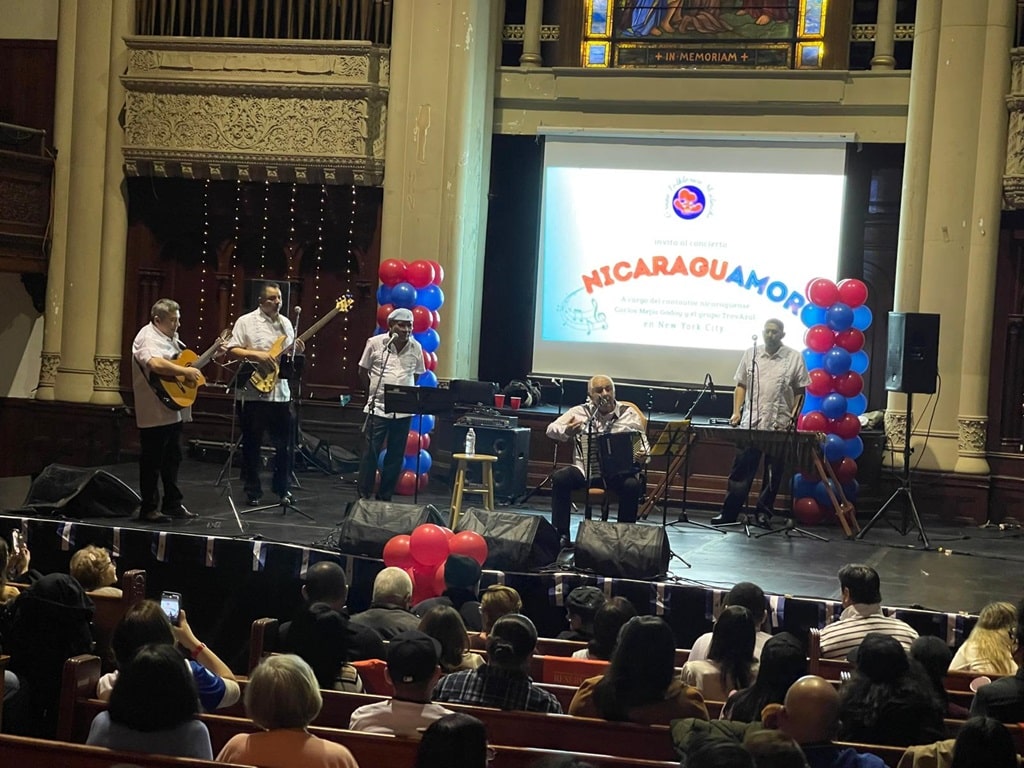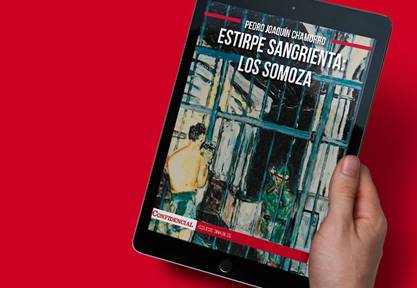24 de septiembre 2018

“NicaraguAmor” Cultural Caravan for Nicaraguans in the USA

PUBLICIDAD 1M
PUBLICIDAD 4D
PUBLICIDAD 5D
The book is released in a new format in homage to the generation of the April 2018 revolution, who have awakened the national conscience.

Cover of the eBook, “Estirpe Sangrienta: Los Somoza” [“Bloody Lineage: the Somoza Family”], designed by Juan Garcia Z. //Confidencial
One night in 1970, during my adolescent years, while poring through the shelves of my father’s library at our home in our Managua neighborhood of Las Palmas, I discovered the book Estirpe Sangrienta: Los Somoza [Bloody Lineage: the Somoza family].
The title was familiar from some conversations I’d overheard at family gatherings, but up until that moment I didn’t know it referred to a book written by my father about the hardships he suffered under the dynastic dictatorship of the last century.
I knew that my Dad, a journalist who was active in the political struggle against Somoza, had been imprisoned, banished and exiled; but at home he never explicitly referred to his book. Nor did he talk about the tortures that he and his companions suffered in the jails around the Tiscapa lagoon, during the days and night of terror that followed the assassination of the tyrant Anastasio Somoza Garcia in Leon on September 21, 1956.
The memoir described all these events in heartrending detail. It’s a document that touches the heart of any Nicaraguan with a minimal sense of patriotism, but its effect was even more pronounced for a son coming suddenly face-to-face with the pain and suffering of his father.
I read Estirpe Sangriento in secret with an unrepeatable emotion, and in my father’s testimony I discovered a citizen with indestructible convictions about freedom, democracy and social justice. A Christian who preaches and convinces you with his example. From that time on, I was seized by a deep feeling of complicity with him, beyond the affection and unconditional love that we shared. With youthful illusion, I promised myself that I would protect him so that nothing would ever happen to him; this was a promise that I couldn’t keep, as I learned on January 10, 1978.
That’s how my personal connection with Estirpe Sangrienta began. I’m sure that everyone else also has a story to tell about this text, which has left no one feeling indifferent. The few copies of the book that circulated from hand to hand prior to 1978, transformed it into a foundational textbook for the creation of a patriotic conscience in several generations of Nicaraguans, whose diverse paths converged in the struggle against the Somoza dictatorship.
The book was initially published in Mexico in 1957, and has gone through at least six editions since then: in Mexico, Buenos Aires and Managua.
In his original prologue, my father wrote: “Everything in the pages of the current book is true, absolutely true, and the author’s objective has been to tell the story as plainly as possible without any kind of exaggeration. Its content is framed within the chronology of a prison sentence suffered by a man who was taken prisoner on September 21, 1956 from a house in the Mantica neighborhood of Managua, Nicaragua.”
“He was detained, as were so many others; like him, he remained for a long time in the jails of the Somoza family and was the object of brutal treatment.”
“He witnessed and suffered tortures, met prisoners who were later executed, experienced a historic trial that, given its set-up and proceedings, deserves to be classified as the darkest American judicial error of our epoch. Now he narrates his experience with the intention of disclosing it for the benefit of those who struggle against tyranny in Nicaragua and in other parts of the Americas.”
“I also hope that it serves to explain to the children of those who have been murdered by the Somoza regime, the reason for their parents’ sacrifice.”
Given the scope and the authenticity of his testimony, its historic value and its literary quality, Estirpe Sangriento has been considered one of the most important books of the twentieth century in Nicaragua, and also as a pioneering work of Latin American narrative journalism.
We Nicaraguans are under an obligation to learn from the disastrous lessons of our past, and above all to honor the memory of those who – like Pedro Joaquin Chamorro with his sacrifice forty years ago – opened the path of freedom that today an authoritarian power is attempting to rip away from us.
In January of this year, at the commemoration to the 40th anniversary of the assassination of my father, Confidencial published Estirpe Sangrienta as an online series, citing its relevance at a time when there’s a new attempt in Nicaragua to impose a dynastic dictatorship headed by the Ortega-Murillo regime. Tens of thousands of people avidly read the thirty-five chapters of the series.
Nine months later, the Nicaraguan people have leapt into civic rebellion, many have been massacred by the dictatorship and yet citizens vow to continue in the struggle until they conquer their freedom. Given all this, we’ve decided to publish Estirpe Sangrienta once more: this time as an ebook with a PDF version and a version in ePub format with interactive features, so that it can be read from any application that allows the reading of electronic books.
During the week that marks our independence from Spain and the birthday of Pedro Joaquin Chamorro, we dedicate the new edition of the book to the generation of the 2018 April revolution: to the young people who awakened the national conscience, so that, as Pedro Joaquin Chamorro famously said, “Nicaragua can become a Republic again.”
I am convinced that this book written over 60 years ago aptly summarizes the reasons and the motivations to continue struggling until we banish the dynastic dictatorship of the 21st century and take up the reforms that will allow us to found a citizens’ republic, based on the values of democracy and social justice.
Access to this collectable book offered by Confidencial is completely free. It will be available for download until next Sunday, September 30. The only thing we request is that you fill out a simple form with your identification and some basic data, so that we can remain in contact and you can help enrich this national conversation in which the lessons of our past are intertwined with the challenges of today and tomorrow.
Thank you,
Carlos Fernando Chamorro
Archivado como:
PUBLICIDAD 3M
Periodista nicaragüense, exiliado en Costa Rica. Fundador y director de Confidencial y Esta Semana. Miembro del Consejo Rector de la Fundación Gabo. Ha sido Knight Fellow en la Universidad de Stanford (1997-1998) y profesor visitante en la Maestría de Periodismo de la Universidad de Berkeley, California (1998-1999). En mayo 2009, obtuvo el Premio a la Libertad de Expresión en Iberoamérica, de Casa América Cataluña (España). En octubre de 2010 recibió el Premio Maria Moors Cabot de la Escuela de Periodismo de la Universidad de Columbia en Nueva York. En 2021 obtuvo el Premio Ortega y Gasset por su trayectoria periodística.
PUBLICIDAD 3D